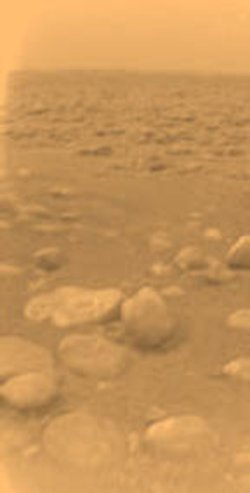
With the European Planetary Science Congress now in session in Potsdam, we should have several interesting presentations to discuss this week, the first of which involves Titan. Huygens and Cassini have shown us a frigid, rocky surface under a surreal orange cloud of hydrocarbons, a place where liquid methane seems to flow in lakebeds and rivers. Methane in these circumstances plays much the same role that water plays here on Earth.
Image: The surface of Titan as seen by the Huygens probe. Credit: ESA/NASA/JPL/University of Arizona.
But what’s under that interesting surface? The permafrost crust seems to sit on a soggy layer of ammonia, methane and water, beneath which an icy layer should surround a rocky core. It’s that icy layer that interests Vasili Dimitrov (Tel-Aviv University), who is discussing its nature at the Potsdam conference. Dr. Dimitrov is hoping to put limits on the methane reserve available within Titan, which will tell us, among other things, whether that thick atmosphere can be retained indefinitely.
For methane poses problems over the long haul. Says Dimitrov:
“If Titan runs out of methane and loses its ‘veil’, it will become a completely different type of astrophysical body. Methane drives the chemical reactions in Titan’s atmosphere but, because it’s so highly reactive and therefore short-lived, it must be replenished. We need to find out just how much methane is stored in the primordial reserve in Titan’s interior at a level where it can escape to the surface. To do this, we need to know how efficiently the methane molecules were packed away when the reserve formed.”
Answering these questions invokes the issue of clathrates, the molecular structures within which the trapped methane must exist in this icy internal environment. We’ve run into clathrates repeatedly as scientists have tried to figure out the geyser mechanism on Enceladus. Now we learn that they’re critical to Titan’s future as well, because the efficiency of methane packing in the clathrate molecular structure tells us whether enough was created during the moon’s early history to keep its atmosphere viable. What’s needed, says Dimitrov, is more experimental work on the nature of methane transfer between Titan’s various internal layers.
Also needed is a better description of Titan’s accretion and evolution, a project that is clearly going to take time, though Cassini-Huygens data should continue to clarify the picture. Optimal efficiency for the trapped methane would occur only if the clathrates formed slowly at temperatures close to absolute zero. Learning more about Titanian clathrates, then, may give us clues about the earliest history of this enigmatic world.


arXiv:0708.2158
Date: Thu, 16 Aug 2007 08:58:16 GMT (87kb)
Title: Clathrate hydrates as a sink of noble gases in Titan’s atmosphere
Authors: C. Thomas, O. Mousis, V. Ballenegger and S. Picaud
Categories: astro-ph
Comments: Astronomy & Astrophysics Letters, in press
We use a statistical thermodynamic approach to determine
the composition of clathrate hydrates which may form from a
multiple compound gas whose composition is similar to that
of Titan’s atmosphere. Assuming that noble gases are initially
present in this gas phase, we calculate the ratios of xenon,
krypton and argon to species trapped in clathrate hydrates.
We find that these ratios calculated for xenon and krypton
are several orders of magnitude higher than in the coexisting
gas at temperature and pressure conditions close to those of
Titan’s present atmosphere at ground level. Furthermore
we show that, by contrast, argon is poorly trapped in these
ices. This trapping mechanism implies that the gas-phase is
progressively depleted in xenon and krypton when the
coexisting clathrate hydrates form whereas the initial
abundance of argon remains almost constant.
Our results are thus compatible with the deficiency of Titan’s
atmosphere in xenon and krypton measured by the Huygens
probe during its descent on January 14, 2005. However, in
order to interpret the subsolar abundance of primordial Ar
also revealed by Huygens, other processes that occurred
either during the formation of Titan or during its evolution
must be also invoked.
http://arxiv.org/abs/0708.2158 , 87kb
Hi All
Titan’s atmosphere might only be metastable – a bit cooler and it might freeze out. Or so one theory goes. The methane greenhouse effect is the only thing preventing a runaway collapse of the nitrogen atmosphere.
Fasten your seat belts, turbulence ahead – lessons from Titan
Ever spilled your drink on an airline due to turbulence?
Researchers on both sides of the Atlantic are finding new
ways to understand the phenomenon – both on Earth and
on Titan.
More at:
http://www.esa.int/esaSC/SEMVKQLPQ5F_index_0.html
Titan’s rotation: A 3-dimensional theory
Authors: B. Noyelles, A. Lemaitre, A. Vienne
(Submitted on 25 Oct 2007)
Abstract: We study the forced rotation of Titan seen as a rigid body at the equilibrium Cassini state, involving the spin-orbit synchronization. We use both the analytical and the numerical way. We analytically determine the equilibrium positions and the frequencies of the 3 free librations around it, while a numerical integration associated to a frequency analysis give us a more synthetic complete theory, where the free solution is splitted from the forced one. We find a mean obliquity of 2.2 arcmin, and the fundamental frequencies of the free librations of about 2.0977, 167.4883 and 306.3360 years. Moreover, we enlight the main role played by Titan’s inclination on its rotation, and we suspect a likely resonance involving Titan’s wobble.
Comments: accepted for publication in Astronomy ans Astrophysics
Subjects: Astrophysics (astro-ph)
Cite as: arXiv:0710.4950v1 [astro-ph]
Submission history
From: Beno\^it Noyelles [view email]
[v1] Thu, 25 Oct 2007 20:09:03 GMT (173kb)
http://arxiv.org/abs/0710.4950
Organic building blocks found in Titan’s atmosphere:
http://www.ucl.ac.uk/media/library/OrganicBuildingBlocks